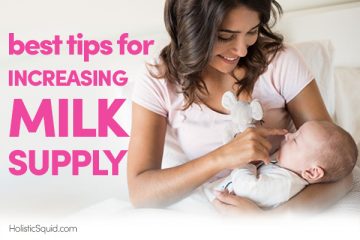
Apparently I have a lot to say about attachment parenting. Be sure to read: Co-Sleeping vs. Baby Sleep Training: The Great Debate, Why I Ditched Attachment Parenting, and Baby Sleep Training: Transform Your Fears.
The very phrase “attachment parenting”reminds me of being nine months pregnant, perplexed, and pouring over my thick, purple-and-white Dr. Sears book. I was trying to understand what I was going to do with the little baby that would soon be in my arms rather than in my belly.
I had four different baby-wearing contraptions ready to go, I had my co-sleeper snuggled up to the bed, and I was all geared up for bonding after birth and successful breast-feeding.
I love the concepts of attachment parenting, which promote bonding, confidence, trust between caregiver and child and an understanding of intimacy and love for the baby and parents. AP babies are said to have better behavior, development, and learning skills.
One of the best things about attachment parenting in my opinion is that when you are co-sleeping with your baby, you don't have to get out of bed in the middle of the night and run down the hall to answer his cries. Once you get the hang of breastfeeding on your side, you barely even have to wake up as you roll over for nighttime feedings.
Sears states clearly that attachment parenting is a “starter style,” an approach rather than a set of rules, and a tool for responsive parenting. I agree, and when taken as a guideline and a starting point, attachment parenting is a sweet, nurturing way of connecting with and getting to know your baby.
The 7 baby B's of attachment parenting according to William Sears:
#1 – Birth bonding
This involves a strong commitment to bonding physically and emotionally with your baby starting as near as possible to the moment of birth.
In hospital settings, baby may be whisked away before bonding can occur. Parents should be clear and insistent beforehand about their wishes to have baby in skin-to-skin contact immediately after birth. If medical complications keep you separated for some time, catch-up bonding can help early attachment develop as soon as possible.
#2 – Breastfeeding
AP views breastfeeding as healthy for baby as well as helpful to moms. As it facilitates bonding, it helps moms learn to read their baby's cues.
To be sure you have the support you need, ask your midwife or birth team for a recommendation of a lactation consultant, or contact your local La Leche League.
#3 – Baby-wearing
The idea here is that physical attachment supports your baby's physical and emotional development and makes you both more comfortable and happy.
New moms (and dads!) will be amazed by the variety of baby slings, wraps, backpack frames and other types of carriers available to make carrying baby comfortable, convenient and safe in many different situations. Babywearers like the Ergo are a great alternative to bulky strollers, especially when traveling on the bus or up stairs.
#4 – Bedding close to baby
Which means co-sleeping or as close to it as you feel comfortable.
For years, medical experts have sounded the, “Don't sleep with baby” cry. But today studies show it's not only safe, but healthy to co-sleep with baby. Sleeping with baby supports breastfeeding, something that doesn't always come easy.
Babies and mothers sleep better together, night-time breast feedings are much simpler, and co-sleeping has been shown to reduce the risk of SIDS and help babies thrive.
#5 – Belief in the language value of your baby's cry
This means that a baby's cry is a signal designed for the survival of the baby and the development of the parents.
Infants cry to communicate, not to manipulate, so when you respond to your baby's cries, you build trust.
#6 – Beware of baby trainers
AP is whole-heartedly against any form of parenting that involves clock or schedule-based timetables or “letting the baby cry-it-out.”
While less “restrained” parenting styles may work for some families, it is definitely a point where AP loses some parents.
The best approach may be to seek a balance between your baby's needs and your own needs that doesn't create too much distance.
#7 – Balance
AP parenting is about balancing loving, nurturing care-giving while at the same time, helping your child develop into a responsible and delightful individual. It isn't about a set of rules, but forging a strong connection with your child that will naturally guide you in parenting.
Use attachment parenting as a starting point
As with any style of parenting, don't commit to the whole philosophy without allowing flexibility for what resonates best with your family.
For me, at some point around 5 – 6 months old, my kid simply got too heavy to carry around in a sling or wrap for any extended period of time, whereas others' babies may be easily tote-able through toddler years.
And after nearly a year of co-sleeping, my husband and I decided we wanted our bed back, and (ear muff for the AP die-hards) we did use some measured cry-it-out techniques to make this challenging transition. We still integrate many of the suggestions and intentions of Attachment Parenting, but within the reality of our lives.
A good starting point for AP is to commit to breastfeeding and insist on birth bonding no matter how you choose to birth your baby. Test out lots of baby carriers to find one that's comfy, and consider how you feel about sleeping with or, at least, very near your baby.
For more info on Attachment Parenting, visit the AP guru: www.askdrsears.com.
Want to learn more? Read this…
The Attachment Parenting Book : A Commonsense Guide to Understanding and Nurturing Your Baby
Not sure attachment parenting is for you? Be sure to read:
Co-Sleeping vs. Baby Sleep Training: The Great Debate,
Why I Ditched Attachment Parenting, and
Baby Sleep Training: Transform Your Fears.
What parenting styles (if any) work best for you?












Leave a Reply